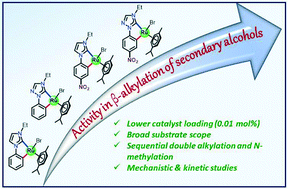Electronically tuneable orthometalated RuII–NHC complexes as efficient catalysts for C–C and C–N bond formations via borrowing hydrogen strategy†
Abstract
The catalytic activities of a series of simple and electronically tuneable cyclometalated RuII–NHC complexes (2a–d) were explored in various C–C/N bond formations following the borrowing hydrogen process. Slight modifications in the ligand backbone were noted to tune the activities of these complexes. Among them, the complex 2d featuring a 1,2,4-triazolylidene donor with a 4-NO2–phenyl substituent displayed the highest activity for the coupling of diverse secondary and primary alcohols with a low catalyst loading of 0.01 mol% and a sub-stoichiometric amount of inexpensive KOH base. The efficacy of this simple system was further showcased in the challenging one-pot unsymmetrical double alkylation of secondary alcohols using different primary alcohols. Moreover, the complex 2d also effectively catalyses the selective mono-N-methylation of various aromatic and aliphatic primary amines using methanol to deliver a range of N-methyl amines. Mechanistically, the β-alkylation reaction follows a borrowing hydrogen pathway which was established by the deuterium labelling experiment in combination with various control experiments. Intriguingly, in situ1H NMR and ESI-MS analyses evidently suggested the involvement of a Ru–H species in the catalytic cycle and further, the kinetic studies revealed a first order dependence of the reaction rate on the catalyst as well as the alcohol concentrations.



 Please wait while we load your content...
Please wait while we load your content...